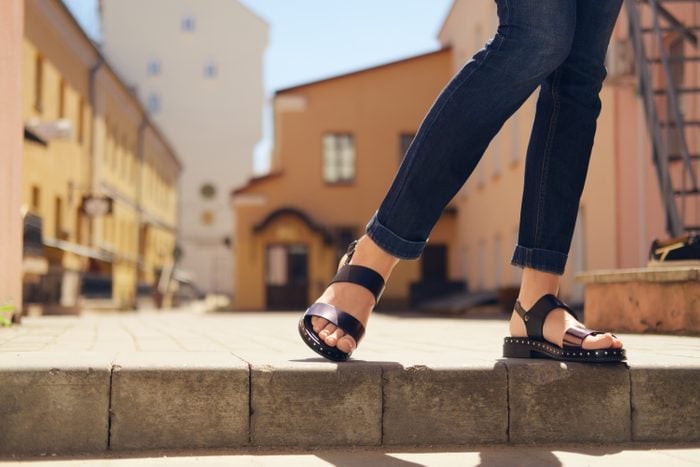How to Find Summer Sandals That Won’t Wreck Your Feet

Stylish summer sandals can be comfortable too, if you know what to look for.
Whether you’re walking around the city or exploring the great outdoors, finding a stylish but supportive sandal can be a huge challenge. Along with warmer weather, clear skies and longer days, the summertime heat can also lead to foot problems like blisters, corns, tendonitis and plantar fasciitis.
So, how do you keep your feet comfortable while still looking stylish? We spoke with Dr. Amandeep Randhawa, a Vancouver-based podiatrist at Metro Vancouver Podiatry, to find the best sandals for summer.
(Related: 7 Beauty Products That Will Tend to All Your Foot Woes This Summer )
What are some common summer feet problems?
According to Randhawa, there are two types of summer feet problems: skin issues and problems with the tissues and tendons.
Skin issues include cracked dry skin, blisters and corns—all of which are super common in the summer because of the combination of heat, sweat and friction. These problems are also exacerbated by ill-fitting shoes.
Issues like tendonitis and plantar fasciitis also become more common in the summertime. Tendonitis, which is the inflammation of the tendons (most commonly the Achilles tendon which runs along the back of your foot, above the heel) is a common foot injury that spikes in the summer thanks to a more active lifestyle in the warmer months. “People who don’t usually play sports all of a sudden become active in the summer,” says Randhawa. “So they’ll injure themselves.” The same cause is behind plantar fasciitis, the inflammation of a thick band of tissue that runs across the bottom of your feet and can cause stabbing pain when walking. Both problems get worse when you don’t have comfortable sandals.
(Related: 7 Shoe Mistakes You’re Making That Hurt Your Feet)
What style of sandal will keep me comfortable all day?
While Randhawa doesn’t endorse any particular style, shape or brand, she does note that there are a few components to look for when shopping for summer sandals.
First, you want to make sure your shoe has a short, supportive heel. “People always say that flat shoes are better, but they could potentially be worse,” Randhawa says. “You don’t want to wear a stiletto or something, but having a little bit of heel support and arch support is important.”
In terms of what to look for in the heel, Randhawa suggests something that’s one to two centimeters high and the sandal should have a deep heel cup to cradle your foot.
Then, make sure your foot is stable in the sandal—this will make the shoe more supportive and comfortable, and will also cut down on blister-causing friction. Randhawa suggests finding a shoe with a strap around your ankle (or at least a slingback) and says the shoe should have at least two straps holding the top of your foot in. That way, there’s less of a chance the sandal will flip off or trip you.
(Related: 7 Foot Peel Masks, Available in Canada, for Softer Feet)
What materials should I look for?
Foot problems like blisters and corns are caused by friction and certain materials can worsen these skin issues. Randhawa says that the most important thing to consider when looking at a sandal’s material is everything that touches your foot, not just what’s inside the shoe. On top of materials that won’t add friction, look out for materials that are stiff enough to provide heel and arch support.
Generally, Randhawa suggests going with a sole (or insole, depending on what sort of sandal you’re looking at) that’s made with cork or EVA (ethylene-vinyl acetate). These materials are light and can provide a bit of a bounce and shock absorption when you walk. For the top of the shoe (whether you’re going with a style that covers your foot on top, or something that has straps), Randhawa says that suede is a great choice since it can help absorb moisture and keep you comfortable.
Are there certain summer sandal styles I should totally avoid?
According to Randhawa, flip-flops can cause all sorts of problems because they lack support and destabilize your feet. “They make the feet go flip and flop,” she says. In particular, those classic go-to flimsy flip-flops are awful for your feet because they don’t offer any ankle or heel support—which can lead to foot pain or injuries like tendonitis.
“If you’re going out to the pool and you’re just going to be wearing them for a short amount of time, flip-flops are fine,” says Randhawa. But, if you’re planning on walking around or doing something active, she suggests wearing a solid, stable running shoe.
(Related: Homemade Foot Scrubs: 8 Recipes to Pamper Tired Feet)
I’m already having foot problems! How can I find relief?
For foot pain that’s caused by something like tendonitis, the best thing you can do is pre-empt any injuries by stretching before heading out for the day. Randhawa suggests focusing the stretching action on your calves and the bottom of your foot. If you’re already feeling sore, try freezing a water bottle and rolling your foot over it for some relief. “The rolling helps stretch out the fascia and the muscles while the ice will calm down inflammation,” she says.
For skin problems like corns and callouses, Randhawa strongly suggests not using over-the-counter removal products. Instead, she advises sticking with a good ol’fashioned pumice stone to gently scrub problem areas down. For blisters, Randhawa says the worst thing you can do is pop it. “Just let it heal and cover it with a loose band-aid,” she says.
As someone who’s plagued with foot issues year-round (which tend to flare up in the summer when I decide that “yeah, flip flops are good for this hike”), I’ve already got a few podiatrist-approved summer sandal options in my shopping cart that are sure to keep my comfortable all season long. And, if all else fails, I can always go back to my trusty sneakers.
Now that you know how to find comfortable summer sandals, learn how to relieve foot pain with home remedies.




